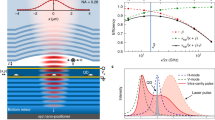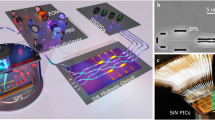Abstract
Single-photon sources based on semiconductor quantum dots offer distinct advantages for quantum information, including a scalable solid-state platform, ultrabrightness and interconnectivity with matter qubits. A key prerequisite for their use in optical quantum computing and solid-state networks is a high level of efficiency and indistinguishability. Pulsed resonance fluorescence has been anticipated as the optimum condition for the deterministic generation of high-quality photons with vanishing effects of dephasing. Here, we generate pulsed single photons on demand from a single, microcavity-embedded quantum dot under s-shell excitation with 3 ps laser pulses. The π pulse-excited resonance-fluorescence photons have less than 0.3% background contribution and a vanishing two-photon emission probability. Non-postselective Hong–Ou–Mandel interference between two successively emitted photons is observed with a visibility of 0.97(2), comparable to trapped atoms and ions. Two single photons are further used to implement a high-fidelity quantum controlled-NOT gate.
This is a preview of subscription content, access via your institution
Access options
Subscribe to this journal
Receive 12 print issues and online access
$259.00 per year
only $21.58 per issue
Buy this article
- Purchase on Springer Link
- Instant access to full article PDF
Prices may be subject to local taxes which are calculated during checkout




Similar content being viewed by others
References
Pan, J-W. et al. Multi-photon entanglement and interferometry. Rev. Mod. Phys. 84, 777–838 (2012).
Kok, P. et al. Linear optical quantum computing with photonic qubits. Rev. Mod. Phys. 79, 135–174 (2007).
O'Brien, J. L., Furusawa, A. & Vuckovic, J. Photonic quantum technologies. Nature Photon. 3, 687–695 (2009).
Kimble, H. J. The quantum internet. Nature 453, 1023–1030 (2008).
Hong, C. K., Ou, Z. Y. & Mandel, L. Measurement of subpicosecond time intervals between two photons by interference. Phys. Rev. Lett. 59, 2044–2046 (1987).
Lounis, B. & Orrit, M. Single-photon sources. Rep. Prog. Phys. 68, 1129–1179 (2005).
Shields, A. J. Semiconductor quantum light sources. Nature Photon. 1, 215–223 (2007).
Michler, P. et al. A quantum dot single-photon turnstile device. Science 290, 2282–2285 (2000).
Santori, C., Pelton, M., Solomon, G., Dale, Y. & Yamamoto, Y. Triggered single-photons from a quantum dot. Phys. Rev. Lett. 86, 1502–1505 (2001).
Dousse, A. et al. Ultrabright source of entangled photon pairs. Nature 466, 217–220 (2010).
Fushman, I. et al. Controlled phase shifts with a single quantum dot. Science 320, 769–772 (2008).
Yilmaz, S. T., Fallahi, P. & Imamoglu, A. Quantum-dot-spin single-photon interface. Phys. Rev. Lett. 105, 033601 (2010).
Young, A. B. et al. Quantum-dot-induced phase shift in a pillar microcavity. Phys. Rev. A 84, 011803 (2011).
Yao, W., Liu, R. B. & Sham, L. J. Theory of control of the spin–photon interface for quantum networks. Phys. Rev. Lett. 95, 030504 (2005).
Santori, C., Fattal, D., Vuckovic, J., Solomon, G. & Yamamoto, Y. Indistinguishable photons from a single-photon device. Nature 419, 594–597 (2002).
Bennett, A. J. et al. Influence of exciton dynamics on the interference of two photons from a microcavity single-photon source. Opt. Express 13, 7772–7778 (2005).
Weiler, S. et al. Highly indistinguishable photons from a quantum dot in a microcavity. Phys. Status Solidi B 248, 867–871 (2011).
Flagg, E. B. et al. Interference of single photons from two separate semiconductor quantum dots. Phys. Rev. Lett. 104, 137401 (2010).
Patel, R. B. et al. Two-photon interference of the emission from electrically tunable remote quantum dots. Nature Photon. 4, 632–635 (2010).
Santori, C. et al. Single-photon generation with InAs quantum dots. New. J. Phys. 6, 89 (2004).
Muller, A. et al. Resonance fluorescence from a coherently driven semiconductor quantum dot in a cavity. Phys. Rev. Lett. 99, 187402 (2007).
Vamivakas, A. N., Zhao, Y., Lu, C. Y. & Atatüre, M. Spin-resolved quantum-dot resonance fluorescence. Nature Phys. 5, 198–202 (2009).
Flagg, E. B. et al. Resonantly driven coherent oscillations in a solid-state quantum emitter. Nature Phys. 5, 203–207 (2009).
Ulhaq, A. et al. Cascaded single-photon emission from the Mollow triplet sidebands of a quantum dot. Nature Photon. 6, 238–242 (2012).
Ates, S. et al. Post-selected indistinguishable photons from the resonance fluorescence of a single quantum dot in a microcavity. Phys. Rev. Lett. 103, 167402 (2009).
Kiraz, A. et al. Indistinguishable photons from a single molecule. Phys. Rev. Lett. 94, 223602 (2005).
Patel, R. B. et al. Postselective two-photon interference from a continuous nonclassical stream of photons emitted by a quantum dot. Phys. Rev. Lett. 100, 207405 (2008).
Matthiesen, C., Vamivakas, A. N. & Atatüre, M. Subnatural linewidth single photons from a quantum dot. Phys. Rev. Lett. 108, 093602 (2012).
Nguyen, H. S. et al. Ultra-coherent single photon source. Appl. Phys. Lett. 99, 261904 (2011).
Barrett, S. D. & Kok, P. Efficient high-fidelity quantum computation using matter qubits and linear optics. Phys. Rev. A 71, 060301 (2005).
Lindner, N. H. & Rudolph, T. Proposal for pulsed on-demand sources of photonic cluster state strings. Phys. Rev. Lett. 103, 113602 (2009).
Melet, R. et al. Resonant excitonic emission of a single quantum dot in the Rabi regime. Phys. Rev. B 78, 073301 (2008).
Zrenner, A. et al. Coherent properties of a two-level system based on a quantum-dot photodiode. Nature 418, 612–614 (2002).
Wang, Q. Q. et al. Decoherence processes during optical manipulation of excitonic qubits in semiconductor quantum dots. Phys. Rev. B. 72, 035306 (2005).
Ramsay, A. J. et al. Phonon-induced Rabi-frequency renormalization of optically driven single InGaAs/GaAs quantum dots. Phys. Rev. Lett. 105, 177402 (2010).
Mogilevtsev, D. et al. Driving-dependent damping of Rabi oscillation in two-level semiconductor systems. Phys. Rev. Lett. 100, 017401 (2008).
Robinson, H. D. & Goldberg, B. B. Light-induced spectral diffusion in single self-assembled quantum dots. Phys. Rev. B 61, 5086–5089 (2000).
Berthelot, A. et al. Unconventional motional narrowing in the optical spectrum of a semiconductor quantum dot. Nature Phys. 2, 759–764 (2006).
Houel, J. et al. Probing single-charge fluctuations at a GaAs/AlAs interface using laser spectroscopy on a nearby InGaAs quantum dot. Phys. Rev. Lett. 108, 107401 (2012).
Kuhn, A., Hennrich, M. & Rempe, G. Deterministic single-photon source for distributed quantum networking. Phys. Rev. Lett. 89, 067901 (2002).
McKeever, J. et al. Single photons from one atom trapped in a cavity. Science 303, 1992–1994 (2004).
Beugnon, J. et al. Quantum interference between two single photons emitted by independently trapped atoms. Nature 440, 779–782 (2006).
Maunz, P. et al. Quantum interference of photon pairs from two remote trapped atomic ions. Nature Phys. 3, 538–541 (2007).
O'Brien, J. L., Pryde, G. J., White, A. G., Ralph, T. C. & Branning, D. Demonstration of an all-optical quantum controlled-NOT gate. Nature 426, 264–267 (2003).
Langford, N. K. et al. Demonstration of a simple entangling optical gate and its use in Bell-state analysis. Phys. Rev. Lett. 95, 210504 (2005).
Kiesel, N. et al. Linear optics controlled-phase gate made simple. Phys. Rev. Lett. 95, 210505 (2005).
Okamoto, R. et al. Demonstration of an optical quantum controlled-NOT gate without path interference. Phys. Rev. Lett. 95, 210506 (2005).
Pooley, M. A. et al. Controlled-NOT gate operating with single photons. Appl. Phys. Lett. 100, 021103 (2012).
Hofmann, H. F. Complementary classical fidelities as an efficient criterion for the evaluation of experimentally realized quantum operations. Phys. Rev. Lett. 94, 160504 (2005).
Fattal, D., Diamanti, E., Inoue, K. & Yamamoto, Y. Quantum teleportation with a quantum dot single photon source. Phys. Rev. Lett. 92, 037904 (2004).
Scholz, M., Aichlele, T., Ramelow, S. & Benson, O. Deutsch–Jozsa algorithm using triggered single photons from a single quantum dot. Phys. Rev. Lett. 96, 180501 (2006).
Moelbjerg, A., Kaer, P., Lorke, M. & Mørk, J. Resonance fluorescence from semiconductor quantum dots: beyond the Mollow triplet. Phys. Rev. Lett. 108, 017401 (2012).
Acknowledgements
The authors thank Y. Yu, Z. Xi, J. Bowles, K. Chen, C. Matthiesen, X-L. Wang, L-J. Wang, N. Vamivakas and Y. Zhao for helpful discussions. This work was supported by the National Natural Science Foundation of China, the Chinese Academy of Sciences (CAS) and the National Fundamental Research Program (grant nos 2011CB921300, 2013CB933300), and the State of Bavaria. M.A. acknowledges the CAS visiting professorship. C-Y.L. acknowledges the Anhui Natural Science Foundation and Youth Qianren Program.
Author information
Authors and Affiliations
Contributions
M.A., C-Y.L. and J-W.P. conceived and designed the experiments. C.S., S.H. and M.K. grew and fabricated the sample. Y-M.H., Y.H., Y-J.W., D.W., M.A. and C-Y.L. carried out the optical experiments. Y-M.H., S.H., C-Y.L. and J-W.P. analysed the data. C-Y.L. wrote the manuscript, with input from all authors. S.H., C-Y.L. and J-W.P. guided the project.
Corresponding authors
Ethics declarations
Competing interests
The authors declare no competing financial interests.
Supplementary information
Supplementary information
Supplementary information (PDF 1260 kb)
Rights and permissions
About this article
Cite this article
He, YM., He, Y., Wei, YJ. et al. On-demand semiconductor single-photon source with near-unity indistinguishability. Nature Nanotech 8, 213–217 (2013). https://doi.org/10.1038/nnano.2012.262
Received:
Accepted:
Published:
Issue Date:
DOI: https://doi.org/10.1038/nnano.2012.262
This article is cited by
-
Tunable quantum dots in monolithic Fabry-Perot microcavities for high-performance single-photon sources
Light: Science & Applications (2024)
-
Dynamic resonance fluorescence in solid-state cavity quantum electrodynamics
Nature Photonics (2024)
-
Hong–Ou–Mandel interference in colloidal CsPbBr3 perovskite nanocrystals
Nature Photonics (2023)
-
Bright semiconductor single-photon sources pumped by heterogeneously integrated micropillar lasers with electrical injections
Light: Science & Applications (2023)
-
Polarization–orbital angular momentum duality assisted entanglement observation for indistinguishable photons
Quantum Information Processing (2023)



